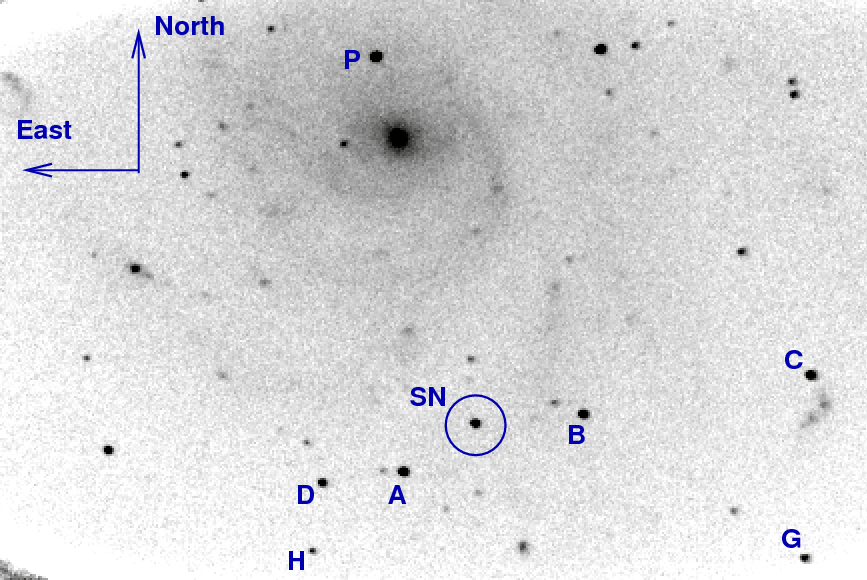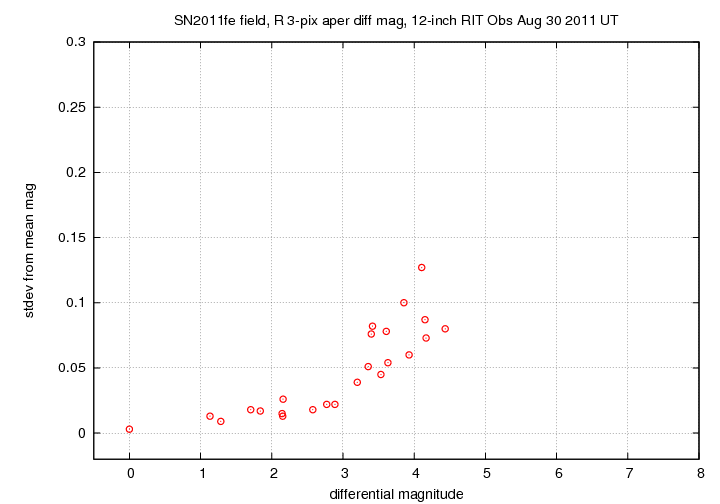
On the night of Aug 29/30, 2011, I observed the newly discovered supernova known as PTF 11kly = SN 2011fe in the galaxy M101.
The setup was:
Notes from the night
This is a chart of the field of SN 2011fe, based on a stack of five R-band images. The field of view is about 10 by 8 arcminutes.

The marked objects appear in a list of comparison stars with magnitudes in BVRI, created by the AAVSO. You can find the original at the AAVSO web site; go to the Variable Star Plotter (VSP) area. I've made a simplified ASCII version of the catalog below, or you can look at the AAVSO's original version in a local copy.
#AUID RA. Dec. Label U B V Rc Ic J H K Comments # Label RA Ra(deg) Dec Dec(deg) ID U B V R I 000-BKD-527 14:03:49.86 [210.95775d] 54:09:05.8 [54.15161d] 117 x - 12.268 (0.057)29 11.735 (0.040)29 11.359 (0.048)29 11.006 (0.054)29 - - - 000-BKD-528 14:04:21.68 [211.09033d] 54:19:22.4 [54.32289d] 119 x - 12.572 (0.068)29 11.948 (0.047)29 11.528 (0.056)29 11.134 (0.063)29 - - - 000-BKD-529 14:02:00.79 [210.50330d] 54:23:15.8 [54.38772d] 128 x - 13.553 (0.062)29 12.751 (0.031)29 12.253 (0.045)29 11.788 (0.056)29 - - - 000-BKD-530 14:01:55.32 [210.48050d] 54:16:21 [54.27250d] 131 x - 13.540 (0.064)29 13.094 (0.044)29 12.716 (0.051)29 12.361 (0.056)29 - - - 000-BKD-531 14:02:02.00 [210.50833d] 54:20:43.9 [54.34553d] 133 x - 14.188 (0.094)29 13.291 (0.057)29 12.772 (0.074)29 12.287 (0.088)29 - - - 000-BKD-532 14:01:49.79 [210.45746d] 54:23:02.7 [54.38408d] 134 x - 14.187 (0.047)29 13.436 (0.033)29 12.970 (0.049)29 12.534 (0.061)29 - - - 000-BKD-533 14:03:13.67 [210.80696d] 54:15:43.4 [54.26205d] 138 A - 14.699 (0.091)29 13.801 (0.046)29 13.230 (0.062)29 12.698 (0.074)29 - - - 000-BKD-534 14:02:54.17 [210.72571d] 54:16:29.5 [54.27486d] 140 B - 14.557 (0.107)29 13.991 (0.074)29 13.581 (0.078)29 13.197 (0.083)29 - - - 000-BKD-535 14:02:29.54 [210.62308d] 54:16:55.2 [54.28200d] 141 C - 14.959 (0.102)29 14.100 (0.045)29 13.598 (0.063)29 13.130 (0.077)29 - - - 000-BKD-536 14:02:31.15 [210.62979d] 54:14:03.9 [54.23442d] 146 G - 15.158 (0.078)29 14.605 (0.029)29 14.204 (0.061)29 13.828 (0.082)29 - - - 000-BKD-540 14:01:50.86 [210.46191d] 54:16:08.1 [54.26892d] 149 x - 15.373 (0.010)29 14.925 (0.000)29 14.635 (0.006)29 14.361 (0.008)29 - - - 000-BKD-538 14:03:23.74 [210.84892d] 54:14:32.6 [54.24239d] 155 H - 16.015 (0.042)29 15.475 (0.000)29 15.133 (0.046)29 14.811 (0.065)29 - - - 000-BKD-539 14:03:05.64 [210.77350d] 54:17:26.2 [54.29061d] 162 x - 16.776 (0.091)29 16.177 (0.000)29 15.640 (0.079)29 15.140 (0.112)29 - - - #Report this sequence as: 5249bgj in the chart field of your observation report. This table is for a 0.25000° fov around PTF11KLY, RA: 14:03:05.81 (210.77421) & Decl.: 54:16:25.40 (54.27372).
I measured the instrumental magnitude of each star with aperture photometry, using a radius of 3 pixels = 4.2 arcseconds in BVRI, and sky defined by an annulus around each star. Following the procedures outlined by Kent Honeycutt's article on inhomogeneous ensemble photometry, I used all stars available in each image to define a reference frame, and measured each star against this frame.
Below is a graph of the scatter in differential magnitude versus magnitude in the ensemble solution for the R-band.

The floor of this diagram is about 0.003 mag, which indicates good data. The floors for each passband were
passband magsig floor -------------------------- B 0.010 V 0.003 R 0.003 I 0.005 --------------------------
Applying the color corrections determined on UT Aug 27 to the ensemble photometry of SN 2011fe and the comparison stars in its field, I find the magnitude of SN 2011fe on this night was:
Passband JD-2,455,000 Mag +/- -------------------------------------------------- B 803.540 11.60 0.08 V 803.551 11.62 0.06 R 803.570 11.46 0.06 I 803.562 11.41 0.08 --------------------------------------------------
The uncertainties here are dominated by the uncertainties in the magnitudes of the comparison stars provided by the AAVSO.
I have just reported these measurements to the AAVSO via their WebObs tool ....
I recently improved my ability to find objects quickly with the 12-inch Meade telescope by adding a video camera on a finder telescope.
Below is a photograph of the video display from this combination, pointed at M13 -- the globular cluster is the fuzzy blob at upper right. North is up and east to the left.

The circled objects are real celestial sources -- the other white spots are mostly video artifacts. The field of view is very roughly about 40 x 40 arcminutes, quite a bit larger than the field of the main CCD camera at Cass focus. The immediate feedback from the video camera makes finding and centering objects much quicker than using the CCD alone. The video camera shows stars down to mag 9-10.
Last modified 8/30/2011 by MWR.